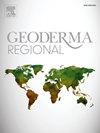定向污泥固碳应用:一种在半干旱土壤中部署的新方法
IF 3.1
2区 农林科学
Q2 SOIL SCIENCE
引用次数: 0
摘要
城市污水污泥有助于土壤养分循环和碳积累。然而,要实现这些效益,需要适当的施用量和合适的现场选择。本研究提出了一种指导农田选择以优化碳积累的方法。该方法将水文和地形数据与污泥施用的历史记录和土壤化学性质相结合,以预测污泥施用后土壤中长期有机碳浓度。利用智利一家污水处理公司14年数据训练的模型,绘制了机会图。在情景分析之后,选择了两个不同土壤条件的田(每个田有8个围场)来评估模型的性能,并评估土壤剖面中的有机碳分布。模型对表层土壤有机碳的均方根误差为6.2 g kg−1,R2值为0.43。机会图显示,自该公司开始运营以来,只有20%的围场接收了污泥,这些围场位于具有有机碳积累潜力的土壤中。案例研究表明,与污泥施用量无关,休耕玉米轮作促进了有机碳的损失。对围场的直接观察表明,有机碳的积累超过了耕作深度。在相似的污泥施用量下,深层、细质地土壤的有机碳含量为156.7±17.0吨ha - 1,而浅层、粗质地土壤的有机碳含量为131.3±14.9吨ha - 1。研究区表层土壤的碳平衡,无论是预测的还是观测的,都是负的。由于污泥应用记录仅包括表土数据,因此不可能计算净碳平衡。所提出的方法准确地反映了围场条件,可以作为选择污泥处置的合适土壤的决策工具,以最大限度地提高土壤碳积累。本文章由计算机程序翻译,如有差异,请以英文原文为准。

Targeted sludge application for carbon sequestration: A novel approach deployed in semi-arid soils
Municipal wastewater sludge can contribute to nutrient recycling and carbon accumulation in soils. However, achieving these benefits requires both an appropriate application rate and suitable field selection. This study proposes an approach to guide field selection to optimize carbon accumulation. The approach integrates hydrological and topographical data with historical records of sludge applications and soil chemical properties to predict medium- to long-term organic carbon concentration in soils following sludge application. An opportunity map was developed using a model trained with 14 years of data from a wastewater company in Chile. Following a scenario analysis, two fields (each with eight paddocks) with contrasting soil conditions were selected to evaluate model performance and assess organic carbon distribution within the soil profile. The model achieved a root mean square error of 6.2 g kg−1 for topsoil organic carbon, with an R2 value of 0.43. The opportunity map revealed that only 20 % of the paddocks that had received sludge since the company started its operations were located in soils with potential for organic carbon accumulation. The case study indicated that fallow-corn rotations promoted organic carbon loss, regardless of the sludge application rate. Direct observations of the paddocks showed that organic carbon accumulated beyond the ploughing depth. Deep, fine-textured soils contained 156.7 ± 17.0 tons ha−1 of organic carbon, whereas shallow, coarse-textured soils had 131.3 ± 14.9 tons ha−1 after similar sludge application rates. The carbon balances for the topsoil, both predicted and observed, were negative for the studied fields. Since sludge application records included only topsoil data, it was not possible to calculate a net carbon balance. The proposed approach accurately reflected paddock conditions and could serve as a decision-making tool for selecting suitable soils for sludge disposal to maximise soil carbon accumulation.
求助全文
通过发布文献求助,成功后即可免费获取论文全文。
去求助
来源期刊

Geoderma Regional
Agricultural and Biological Sciences-Soil Science
CiteScore
6.10
自引率
7.30%
发文量
122
审稿时长
76 days
期刊介绍:
Global issues require studies and solutions on national and regional levels. Geoderma Regional focuses on studies that increase understanding and advance our scientific knowledge of soils in all regions of the world. The journal embraces every aspect of soil science and welcomes reviews of regional progress.
 求助内容:
求助内容: 应助结果提醒方式:
应助结果提醒方式:


